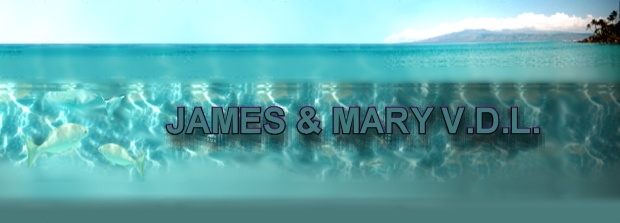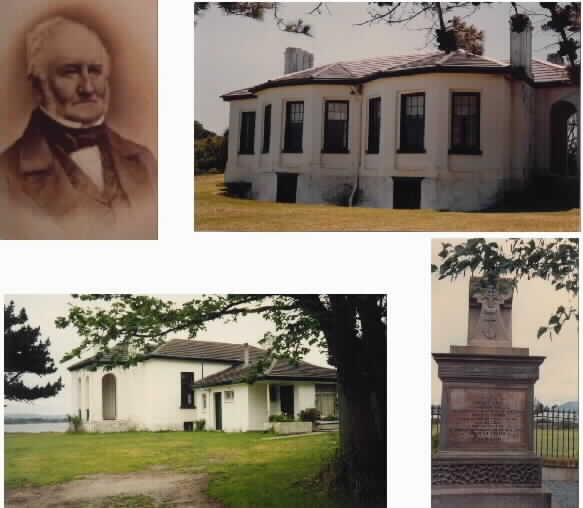
|

|

|
|
1.Photo James Cox (courtesy Robin Hirst) 2. Front view of Marion Villa facing the Tamar River. 3. Marion Villa from approach from road. Grave of James Cox and his family in grounds of St.Andrews Anglican at Evandale.
JAMES COX travelled to V.D.L. to select land on which to settle and raise a family. Being married on 10th June, he was now ready to build his own property, with all the things he had learned in U.K. and in the Hawkesbury. I am not sure just when he made his first move, but James was staying with the Archers of Longford, when he rode out to inspect land in the Evandale region. The land he selected for a grant had access to water from the beautiful South Esk River.
With that done, James returned to N.S.W. to bring his young bride Mary with him, on Colonial Cutter "Elizabeth" on 13th December 1813. (thanks Irene Schaffer). Their first son John was b.20.3.1813 in N.S.W. To James, being a pastoralist, this was probably a very proud moment - with a son to follow in his footsteps, as he had so done, after his father. Indeed, he was able put into practice so much that he had learned about sheep and cattle, along with labour and work practices.
This is a HISTORY IN A NUTSHELL, in an effort to explain the detail of extensive land grants and purchase, as well as the work and accomodation ethic of JAMES COX of CLARENDON, Tasm. References are "A History of Evandale" by K.R.von Steiglitz and "Clarendon - and it's People" a Brief History, which was a joint project of Evandale History Society and Clarendon Committee. My appreciation is expressed to Geoff Cox and Jean Archer, who shared much with me from the earliest times. Archie & Joan Johnson did a great deal of marvellous research to build a background, to the lives of these enterprising people. I was able to acquire primary documents from the Archives of Tasmania which helped a great deal to establish the truth, which is often a little stretched to suit someone's desire for a good story.
I too, hold a host of books, photos, letters and valuable documents in folders and in my library, which allow me to share wonderful detail and stories of my Gr.Gr.Grandparents James & Mary COX and their families. Those who survived married and settled in various places around Australia and overseas. Although I have spent much time since 1986, this page does not allow me space or time to go into too much detail. James Cox was granted land at Port Dalrymple and Gordon's Plains and he eventually held by grant, or by purchase many thousands of acres. He named many of the properties after those of his father and his ancestors in Dorset U.K.
His ancestor William Cox was born c.1695 at "Fern Hill" by the fir forest, which runs down to Poole on the Dorset coast. James Cox's brother Edward built his beautiful "Fern Hill" at Mulgoa, N.S.W. while James also had "Fernhill" near Deddington in Tasmania. "Winburn" Mulgoa and Evandale were named after "Wimborne" birthplace of William Cox (1765-1837). James' brother George (1795-1822) built his "Winbourn" at Mulgoa, N.S.W. (The Will of James Cox records many of his properties and I would be willing to share this with anyone who cares to ask via email.)
It did not take long for James to get involved in civic affairs and he was soon a Magistrate and M.L.A. James and Mary lived on Clarendon Estate for a time, until Mary became afraid of the loneliness of the bush, with bushrangers and native population continually moving around the estate. James bought a property in town, which was named "Staffordshire House"and where he commenced trading as a merchant. The name has been erased, but it is in Charles Street, Launceston and classified by the National Trust. He rode his horse out to his property at Evandale each day.
James Cox was very active in the establishment of many things like the Cornwall Bank, Cornwall Collegiate Institute, The Anglican Church, Cessation of Transportation Committee and many sporting ventures, which he loved and brought to this country from England. James kept Fallow deer, Forester kangaroos, peacocks, pheasants and other animals on his property, descendants of which are said to still roam the Western Tiers region. With James Lord and Walter Glas Chiene of Quorn Hall at Campbell Town, James imported Fox hounds for the Hunts held at "Clarendon". James was Master of the Hunts, which were enjoyed regularly, as hundreds of men rode their horses, across the vast Clarendon Estate.
JAMES preferred to have Bounty Immigrants on the estate, as they were rather more knowledgeable about living on the land and making good use of pastures. James gave each of these families land on which to live and produce their own crops. James exchanged his produce with that of these farm workers (as far as I understand the system.)
A large house, on ground level, was built on "Clarendon Estate", the details of which are to hand and in the above books. James rode to the property each day, to work with his manager in building barns etc. He bred Merino sheep and Hereford cattle, determined to breed quality stock, having learned much from his father William. He was dedicated to the task of breeding quality stock, including his special line of horses from his Arab stallion Hadji Baba. He was instrumental in the establishment of the Turf Club as well as the Northern Agricultural Society at Longford in 1856.
James donated about 250 acres for the building of a church at Lymington, which was renamed NILE, to avoid confusion with Lymington in northern Tasmania. About 200 acres was set aside for a Glebe, which was to help the poor of the parish. Another few acres were set aside for a burial ground and where, on our recent trip to Tasmania we visited the resting place of our dear friend Geoff Cox. We also visited Jean Archer, Alison Cox, Jamie Cox and Joan Johnson, maintaining a link with those who share our forbears and shared history of a wonderful, if not sometimes, difficult past.
From History of Evandale "...the Commissioners crossed the Nile... ..Mr.Cox had more land "Winburn" and nearly in continuation up the river, possesses five thousand acres more, which was "Fernhill". When James Cox died his estate was said to contain almost 16,000 acres." end quote (from "Clarendon and it's People".)
James and Mary had many children before the grand mansion was completed in 1838.
Details of "Clarendon" and his beach house at "Marion Villa" follows.
|

|
|
|
|
Thelma & Matthew at mrbirrell@virginbroadband.com.au |


